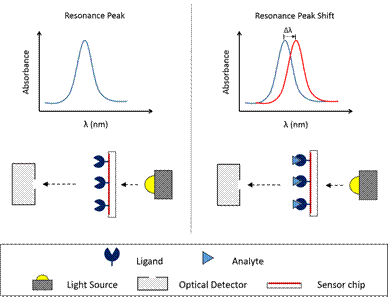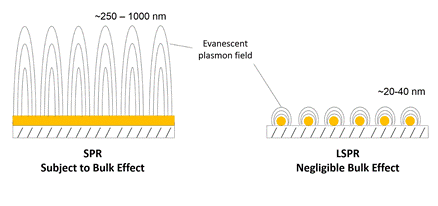Introduction
Surface plasmon resonance (SPR) is a popular label-free technology that helps scientists study the binding interactions between two biomolecules in a quantitative manner.
Other methods simply provide endpoint measurements, for example pull-down assays. While the SPR technology helps to establish the kon, koff and KD of interactions, providing a better understanding of the binding events.
Normally, SPR includes sensors fabricated from thin gold films, which are imperative for the SPR method. However, SPR technology is not accessible to most researchers because of the instrument’s cost and complexity.
Localized surface plasmon resonance
An alternative method to SPR is localized surface plasmon resonance (LSPR), has been studied over the years and is more affordable and accessible than that of SPR. This is the reason the Nicoya Lifesciences OpenSPR system is based on LSPR technology.
Given that LSPR is a relatively new technique, researchers have raised a number of questions about the technique. The following sections summarize these questions, which can help researchers in general to become LSPR experts.
What is LSPR and how is it different from traditional SPR?
Traditional SPR uses a continuous gold film, while LSPR is created through metal nanoparticles, usually silver and gold. A powerful resonance absorbance peak is produced in the visible range of light by LSPR.
The position of this peak is quite sensitive to the local refractive index around the particle. The OpenSPR instrument can determine even slight changes that occur in the absorbance position’s wavelength, instead of the angle seen in the standard SPR technique.
Incident light is used by both LSPR and SPR techniques to jointly stimulate the electrons of a conduction band in a metal. This creates a coherent localized plasmon oscillation, with the resultant resonant frequency mainly relying on the size, composition, dielectric environment, geometry, and separation distance of the conductive band (Figure 1).
In both these methods, response is calculated in real-time, which leads to a binding curve. Several binding curves, obtained through different analyte concentrations are fit to a binding model to find out the kinetic binding constants, for example the kon, koff and KD.

Figure 1. The resonant frequency strongly depends on the composition, size, geometry, dielectric environment, and separation distance of the conductive band.
What are the benefits of LSPR?
The following benefits are of using gold nanoparticles rather than a thin gold film:
- A prism is not required to combine the light for the LSPR technique, meaning the optical hardware is simpler and the system can be made more affordable and more compact
- LSPR has a relatively short electromagnetic field decay length, and therefore, there is less intervention from buffer mismatch; this makes LSPR less sensitive to bulk refractive index changes
- The angle is not essential for LSPR, which leads to a spectral shift and not a change in angle; this makes the instrument more resistant to mechanical noise and vibration
- Since the instrument is less prone to temperature drift, there is no need for any stringent temperature control
- The instrument has a simpler design, which makes it much more easy to use and maintain
- Sensor chips can be fabricated in a more cost-effective way, thanks to the use of gold nanoparticles
How does sensitivity compare to traditional SPR?
When compared to LSPR sensors, SPR sensors have greater refractive index sensitivity (RIS or m). However, both types of sensors show similar sensitivity towards the binding events. This is because gold films limit the response to a smaller sensing volume, while nanoparticles exhibit a relatively shorter electromagnetic decay length (ld).
With a more compact sensing volume, the LSPR technique is less susceptible to bulk effects and more susceptible to molecular binding, which means less interference from bulk signals.
Sensitivity of traditional SPR instruments is 1 RU/pg/mm2, while that of LSPR is 6 RU/pg/mm2. Artifacts induced by buffer refractive index changes, temperature drift, and other such external variables are also minimized. Figure 2 shows the smaller decay length of SPR against LSPR.

Figure 2. The smaller decay length of SPR versus LSPR
What is the signal output in LSPR?
LSPR can determine the wavelength shift change in real-time, usually in picometers (pm), instead of the response units (RU) as often observed in SPR measurements. As an abstract unit, RU does not provide a distinct physical importance. In the case of standard SPR, RU is relative to the change in the reflected light angle induced by a change in the refractive index.
Since LSPR helps to determine the slight changes in the absorbance position wavelength instead of a change in angle change, the output unit is in pm or nm. Conversely, response is determined in real-time, irrespective of the output. This leads to a binding curve in both SPR and LSPR methods.
About Nicoya Lifesciences

Nicoya Lifesciences is a team of engineers and scientists with extensive experience working at the forefront of nanotechnology, biochemistry, and optical sensors.
They come from some of the world's leading research institutions such as the Imperial College of London and the University of Waterloo. They are based in Waterloo, Ontario - known as Canada's Silicon Valley.
Their mission is to bring high quality sensor products with unique, innovative designs to market to solve some of the world's most important problems. They want to drive innovation by giving more people access to powerful sensor technologies and tools.
Sponsored Content Policy: News-Medical.net publishes articles and related content that may be derived from sources where we have existing commercial relationships, provided such content adds value to the core editorial ethos of News-Medical.Net which is to educate and inform site visitors interested in medical research, science, medical devices and treatments.